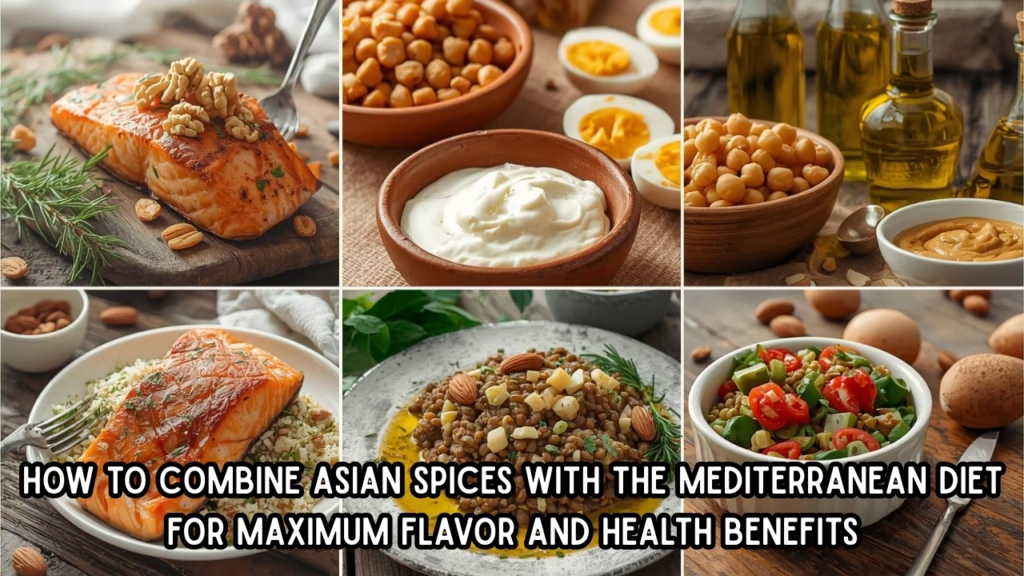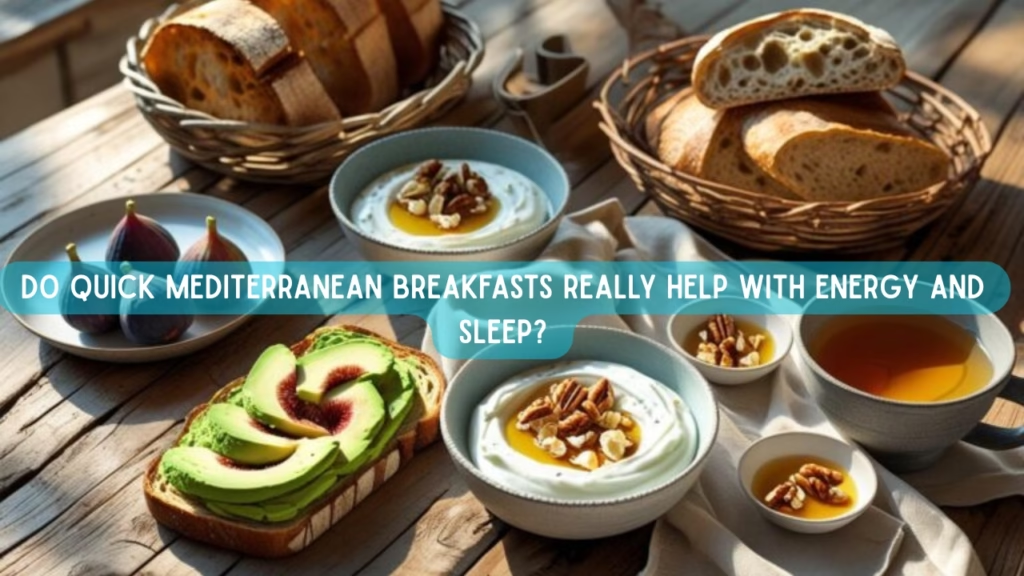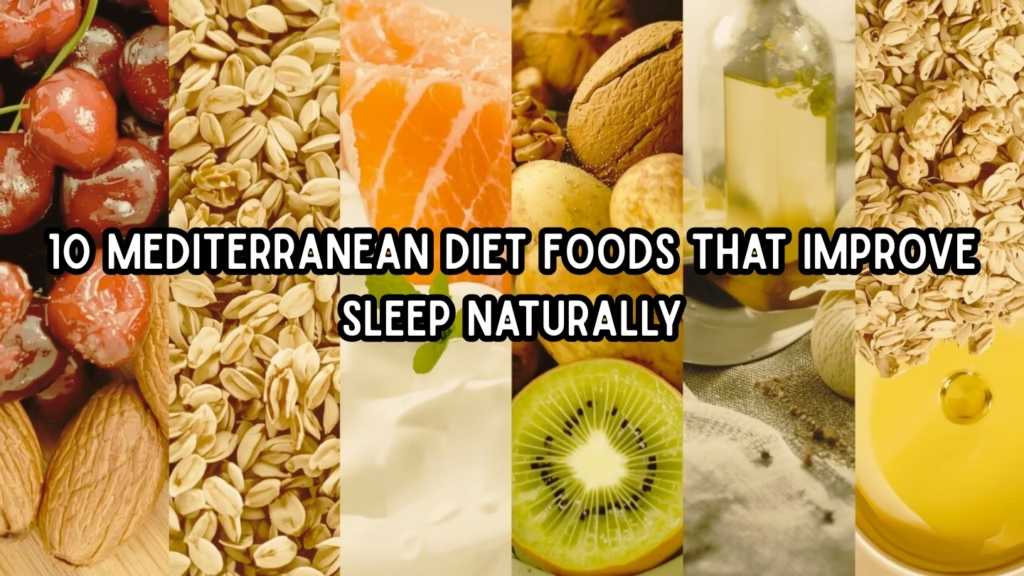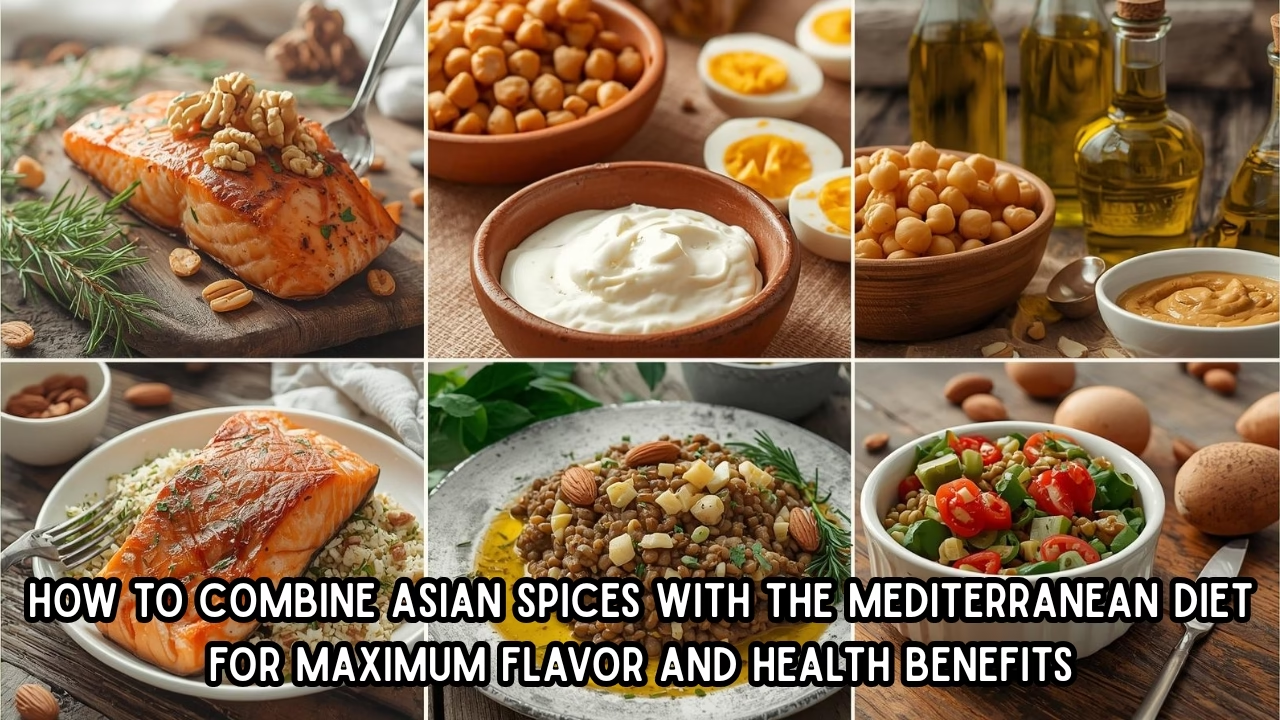
Asian spices with the Mediterranean diet create an extraordinary culinary fusion that doesn’t just taste incredible—it amplifies the health benefits of one of the world’s most celebrated eating patterns. By thoughtfully incorporating the aromatic, medicinal spices of Asia into Mediterranean cooking principles, you unlock new dimensions of flavor while supercharging your meals with additional anti-inflammatory compounds, antioxidants, and healing properties that both traditions have celebrated for millennia.
The beauty of this fusion lies in its natural compatibility. Both Asian and Mediterranean cuisines prioritize fresh vegetables, lean proteins, healthy fats, and abundant plant-based ingredients. They share a philosophy that food should be both medicine and pleasure. When you bridge these two culinary worlds through strategic spice use, you’re not abandoning Mediterranean principles—you’re enhancing them with complementary flavors and phytonutrients that work synergistically to promote optimal health.
Understanding the Natural Bridge Between Asian and Mediterranean Flavors
Asian spices with the Mediterranean diet work harmoniously because both culinary traditions evolved around similar nutritional wisdom, despite being separated by thousands of miles. Mediterranean cooking traditionally emphasizes herbs like oregano, basil, rosemary, and thyme, while Asian cuisines showcase spices such as ginger, turmeric, lemongrass, and star anise. These aren’t competing flavor profiles—they’re complementary palettes that enhance each other when thoughtfully combined.
The Mediterranean diet’s foundation rests on olive oil, vegetables, whole grains, legumes, fish, and modest amounts of poultry and dairy. Asian cooking brings similar elements to the table with its focus on rice, vegetables, tofu, seafood, and plant-based proteins. Where Mediterranean cuisine uses garlic and onion as aromatic foundations, Asian cooking does the same, often adding ginger and lemongrass to the mix. This overlap creates natural entry points for fusion.
What makes this combination particularly powerful is how both traditions use spices not merely for flavor, but for their medicinal properties. Mediterranean cultures have long recognized oregano’s antimicrobial qualities and rosemary’s memory-enhancing compounds. Similarly, Asian traditions have employed turmeric for inflammation, ginger for digestion, and cinnamon for blood sugar regulation for thousands of years. When you combine these wisdom traditions, you’re accessing a broader spectrum of health-promoting compounds than either cuisine offers alone.
The Powerhouse Asian Spices That Elevate Mediterranean Cooking
Asian spices with the Mediterranean diet reach their full potential when you understand which spices to incorporate and how they enhance both flavor and health. Turmeric stands at the forefront of this fusion, offering a warm, earthy flavor that pairs beautifully with Mediterranean staples while delivering powerful anti-inflammatory benefits through its active compound, curcumin. Adding a pinch of turmeric to your olive oil-based salad dressings or stirring it into chickpea stews transforms familiar dishes into anti-inflammatory powerhouses.
Ginger brings a bright, slightly spicy warmth that cuts through rich flavors while settling the stomach and reducing inflammation. Fresh ginger grated into Mediterranean fish marinades alongside lemon and olive oil creates a fusion that honors both traditions. Its anti-nausea properties and ability to support digestive health make it a valuable addition to any meal plan. When combined with Mediterranean garlic, ginger creates an aromatic base that’s greater than the sum of its parts.
Star anise introduces a subtle licorice-like sweetness that works surprisingly well in Mediterranean braises and stews. Its antimicrobial properties and distinctive flavor profile can transform a simple tomato-based fish stew into something exotic yet familiar. Lemongrass offers bright citrus notes without the acidity of lemon, making it perfect for marinating chicken or fish destined for the grill—a quintessentially Mediterranean cooking method enhanced with Asian aromatics.
Cinnamon, while found in both traditions, takes on new dimensions when used in savory Mediterranean-Asian fusion dishes. A stick of cinnamon in your lentil soup or lamb tagine isn’t authentically Mediterranean or Asian—it’s a bridge between both. This warming spice helps regulate blood sugar levels, making it particularly valuable for anyone managing metabolic health. Cardamom pods crushed and added to grain pilafs bring an aromatic complexity that enhances the nutty flavors of farro, bulgur, or brown rice.
Creating Flavor Combinations That Work
Asian spices with the Mediterranean diet shine brightest when you understand flavor pairing principles that make fusion feel natural rather than forced. Start by identifying the aromatic base of traditional Mediterranean cooking—garlic, onion, and olive oil—then enhance it with complementary Asian elements. Sautéing minced garlic and ginger together in olive oil creates a foundation that works for countless dishes, from stir-fried vegetables to pasta sauces with an unexpected twist.
Consider the balance of flavors in each dish. Mediterranean cooking often plays with bright acidity from lemon, rich savoriness from olive oil, and herbal notes from fresh herbs. Asian cuisines add dimensions of umami from soy sauce or fish sauce, heat from chilies, and aromatic complexity from spices like five-spice powder. When combining these elements, think about balance—if you’re adding ginger’s heat, you might reduce black pepper slightly. If you’re incorporating soy sauce’s umami, you might use less salt.
Herb and spice layering becomes an art form in this fusion. Fresh Mediterranean basil pairs beautifully with Thai basil, each contributing different aromatic notes. Rosemary’s piney intensity complements the warming qualities of cinnamon in roasted vegetables. Oregano’s earthiness finds a partner in ground coriander, creating depth in tomato-based sauces. The key is starting with familiar Mediterranean frameworks and thoughtfully introducing one or two Asian spices until you develop an intuitive sense of what works.
Temperature matters when working with spices. Many Asian spices release their full flavor profile when briefly heated in oil—a technique called blooming that also appears in Mediterranean cooking with spices like cumin. Toast whole spices like star anise, cardamom, and cinnamon sticks in olive oil before adding other ingredients. This simple step unlocks aromatic compounds and infuses your cooking oil with layers of flavor that permeate the entire dish.
Health Benefits of This Powerful Culinary Fusion
Asian spices with the Mediterranean diet create a synergistic effect where combined health benefits exceed what either tradition offers independently. The Mediterranean diet’s cardiovascular benefits are well-documented, stemming largely from olive oil’s monounsaturated fats, fish’s omega-3 fatty acids, and abundant antioxidants from fruits and vegetables. When you introduce Asian spices, you’re adding another layer of protective compounds that target inflammation, oxidative stress, and metabolic dysfunction through different biochemical pathways.
Turmeric’s curcumin compounds work differently than the polyphenols in olive oil, yet both reduce inflammation—one of the root causes of chronic disease. When consumed together, particularly with black pepper which enhances curcumin absorption, you’re mounting a multi-pronged defense against inflammatory processes. Research shows that combining different anti-inflammatory compounds often produces better results than any single agent alone, a principle that applies beautifully to this culinary fusion.
Ginger’s gingerol compounds support digestive health while also demonstrating anti-inflammatory and antioxidant properties. The Mediterranean diet already promotes gut health through its fiber-rich vegetables, legumes, and whole grains, but adding ginger can soothe digestive discomfort and potentially enhance nutrient absorption. This matters because even the healthiest diet provides limited benefits if your body can’t properly absorb its nutrients.
Blood sugar regulation becomes more robust when you combine Mediterranean eating patterns with Asian spices like cinnamon, fenugreek, and turmeric. The Mediterranean diet’s emphasis on complex carbohydrates, fiber, and healthy fats already promotes stable blood sugar, but cinnamon has been shown to improve insulin sensitivity. Adding a teaspoon of cinnamon to your morning yogurt with berries and nuts creates a breakfast that manages blood sugar through multiple mechanisms simultaneously.
The antioxidant load of this combined approach is impressive. Mediterranean herbs like oregano and rosemary rank among the most antioxidant-rich plants on Earth, but Asian spices like cloves and star anise score even higher on some measures. By drawing from both palettes, you’re ensuring your body has access to a diverse array of antioxidant compounds that protect cellular health through different mechanisms. This diversity matters because various antioxidants work in different parts of cells and against different types of oxidative damage.
Practical Ways to Start Your Fusion Journey
Asian spices with the Mediterranean diet become approachable when you start with small, intentional modifications to familiar dishes. Begin your mornings by adding ground cardamom and a pinch of turmeric to your Greek yogurt alongside traditional Mediterranean additions like honey, nuts, and fresh fruit. This simple breakfast fusion delivers probiotics from the yogurt, anti-inflammatory compounds from turmeric, and the aromatic complexity of cardamom—all aligned with Mediterranean principles of starting the day with nutrient-dense foods.
Transform your basic Mediterranean salad dressing by whisking together olive oil, lemon juice, minced garlic, grated fresh ginger, a touch of honey, and a dash of toasted sesame oil. This fusion dressing maintains the Mediterranean foundation while introducing ginger’s digestive benefits and sesame oil’s nutty richness. Drizzle it over a salad of mixed greens, chickpeas, cucumber, tomatoes, and grilled fish for a meal that epitomizes East-meets-West harmony.
Your evening grain bowls offer endless fusion possibilities. Cook farro or bulgur wheat—Mediterranean whole grains—then season them with olive oil, garlic, and a blend of za’atar and Chinese five-spice powder. Top with roasted vegetables seasoned with cumin and ginger, grilled salmon marinated in miso and lemon, and a handful of fresh cilantro and mint. Every component maintains Mediterranean diet principles while incorporating Asian flavor dimensions.
Soups and stews provide perhaps the easiest canvas for fusion experimentation. Start with a classic Mediterranean white bean and vegetable soup, but add a few slices of fresh ginger to your aromatic base of garlic and onion. Include a star anise pod while the soup simmers, and finish with a drizzle of sesame oil alongside your olive oil. The result tastes both familiar and intriguingly different, expanding your culinary repertoire while delivering enhanced nutritional benefits.
Building Your Fusion Spice Pantry
Asian spices with the Mediterranean diet require a thoughtfully curated pantry that respects both traditions. Start with the Mediterranean essentials you likely already have—extra virgin olive oil, dried oregano, basil, rosemary, thyme, cumin, and paprika. Then systematically add key Asian spices that offer both culinary versatility and health benefits.
Fresh ginger root should become a refrigerator staple, as fresh ginger delivers more vibrant flavor and higher concentrations of beneficial compounds than dried. Keep it in your crisper drawer and grate it directly into dishes. Fresh turmeric root, increasingly available in well-stocked grocery stores, offers similar advantages over ground turmeric, though the powder form remains useful for its convenience and long shelf life. Store turmeric in a cool, dark place to preserve its curcumin content.
Whole spices like star anise, cardamom pods, cinnamon sticks, and coriander seeds provide more intense, complex flavors than pre-ground versions. Invest in a small spice grinder or use a mortar and pestle to grind them fresh as needed. Whole spices maintain their potency much longer than ground versions—often years instead of months—making them more economical despite higher upfront costs. Toast whole spices in a dry pan before grinding to intensify their aromatic compounds.
Certain specialty items bridge both traditions beautifully. Sesame seeds and sesame oil appear in both Mediterranean and Asian cuisines, making them natural fusion ingredients. Za’atar, a Middle Eastern spice blend, already hints at the possibilities of spice fusion. Chinese five-spice powder, with its blend of star anise, cloves, cinnamon, Sichuan pepper, and fennel, can enhance Mediterranean braises and roasted meats. Keep these blends on hand for quick flavor additions that don’t require measuring multiple individual spices.
Smart Fusion Techniques for Everyday Cooking
Asian spices with the Mediterranean diet work best when you understand cooking techniques that honor both traditions. The Mediterranean practice of building flavor through sofrito—slowly cooking garlic, onions, and sometimes tomatoes in olive oil—becomes more dynamic when you add grated ginger or lemongrass to the mix. This aromatic base then flavors everything from seafood stews to vegetable braises, infusing the entire dish with fusion character from the start.
Marinating transforms Mediterranean grilled foods into fusion masterpieces. Traditional Mediterranean marinades combine olive oil, lemon juice, garlic, and herbs. Enhance these by adding grated ginger, a splash of low-sodium soy sauce, crushed lemongrass, or a paste made from turmeric and black pepper. Let fish, chicken, or tofu sit in these fusion marinades for thirty minutes to several hours, allowing the spices to penetrate the protein while tenderizing it. The high heat of grilling caramelizes the marinade’s sugars and spices, creating complex flavor layers.
Spice rubs offer another avenue for fusion. Create a blend of Mediterranean herbs—dried oregano, thyme, and rosemary—mixed with Asian spices like ground ginger, turmeric, and Chinese five-spice powder. Add salt, black pepper, and a touch of smoked paprika for depth. Rub this mixture onto fish, chicken, or vegetables before roasting or grilling. The dry application creates a flavorful crust while the spices’ health compounds remain concentrated on the food’s surface where your taste buds can fully appreciate them.
Finishing oils and drizzles allow you to add fusion elements at the end of cooking, preserving delicate flavors and aromatic compounds that might dissipate with heat. Prepare a ginger-infused olive oil by gently warming olive oil with sliced ginger, then straining and storing it. Drizzle this over finished dishes for a final flavor boost. Similarly, a turmeric-black pepper oil can add both color and anti-inflammatory power to soups, grains, and roasted vegetables right before serving.
Sample Fusion Meals for Every Occasion
Asian spices with the Mediterranean diet come to life through complete meals that showcase how seamlessly these traditions merge. For breakfast, prepare a Mediterranean-style frittata with vegetables, feta cheese, and fresh herbs, but season your sautéed vegetables with a combination of oregano and ground turmeric. Serve alongside whole grain toast drizzled with olive oil and sprinkled with za’atar and black sesame seeds. This meal delivers the Mediterranean diet’s emphasis on vegetables, whole grains, and healthy fats while incorporating Asian spices’ anti-inflammatory properties.
Lunch might feature a grain bowl that epitomizes fusion principles. Cook quinoa or brown rice and toss it with olive oil, lemon juice, and a pinch of turmeric. Top with roasted chickpeas seasoned with cumin and Chinese five-spice, a variety of raw and roasted vegetables, pickled ginger, fresh herbs like cilantro and mint, and grilled salmon seasoned with a ginger-garlic rub. Drizzle with a tahini sauce enhanced with a touch of sesame oil and fresh lime juice. Every element aligns with Mediterranean diet principles while Asian spices weave throughout.
Dinner offers opportunities for more elaborate fusion dishes. Prepare a Mediterranean fish stew as your base—tomatoes, fennel, white wine, and olive oil—but add lemongrass stalks, ginger, and a star anise pod to the broth. Use Mediterranean fish like sea bass or snapper, add some mussels or shrimp, and finish with fresh cilantro alongside traditional parsley. Serve over whole wheat couscous or rice noodles. The result tastes neither purely Mediterranean nor exclusively Asian but occupies a delicious middle ground that amplifies the best of both.
Even simple weeknight dinners benefit from fusion thinking. Stir-fry vegetables in olive oil instead of traditional vegetable oil, season with both Mediterranean herbs like oregano and Asian spices like ginger and garlic, and serve over farro or bulgur wheat instead of white rice. Add grilled tofu or fish for protein, and finish with a drizzle of extra virgin olive oil and toasted sesame seeds. This meal takes fifteen minutes but delivers impressive nutritional density and complex, satisfying flavors.
Adapting Traditional Recipes for Fusion Success
Asian spices with the Mediterranean diet open new possibilities for traditional recipes from both cuisines. Take a classic Greek lemon chicken and enhance it with fresh ginger in the marinade. The ginger’s warmth complements lemon’s brightness while adding anti-inflammatory properties. The dish remains recognizably Greek yet offers an unexpected dimension that makes familiar flavors exciting again.
Italian pasta dishes welcome Asian spice integration beautifully. A simple aglio e olio—garlic and olive oil pasta—becomes transcendent when you add thinly sliced fresh ginger and a touch of red chili flakes alongside the traditional garlic. Toss with whole wheat spaghetti, add some sautéed greens, finish with lemon zest and toasted sesame seeds, and you’ve created a fusion dish that feels both comforting and novel.
Asian stir-fries adapt easily to Mediterranean principles. Instead of using high-heat vegetable oils, cook your vegetables in olive oil at slightly lower temperatures—a method that preserves both the vegetables’ nutrients and the olive oil’s beneficial compounds. Use Mediterranean vegetables like zucchini, eggplant, and bell peppers alongside Asian favorites like bok choy and snow peas. Season with traditional Asian aromatics—ginger, garlic, and lemongrass—but add dried oregano or fresh basil at the end for an unexpected Mediterranean touch.
Middle Eastern dishes, which already occupy a space between Mediterranean and Asian cuisines, provide natural fusion opportunities. Hummus becomes more interesting with a swirl of turmeric-spiced olive oil on top. Falafel mixtures benefit from adding ground coriander and a pinch of Chinese five-spice to the traditional cumin and parsley. Baba ganoush gains complexity when you roast the eggplant with whole star anise pods before blending.
Maximizing Nutritional Benefits Through Smart Combinations
Asian spices with the Mediterranean diet deliver maximum health benefits when you understand nutrient synergies. Turmeric’s curcumin absorbs poorly on its own, but combining it with black pepper increases bioavailability by up to two thousand percent. The Mediterranean diet’s emphasis on healthy fats further enhances curcumin absorption, as it’s fat-soluble. Therefore, a simple combination of turmeric, black pepper, and olive oil creates optimal conditions for your body to utilize this powerful anti-inflammatory compound.
Pairing vitamin C-rich Mediterranean vegetables like tomatoes and bell peppers with iron-rich Asian ingredients like sesame seeds and certain spices enhances iron absorption. Adding a squeeze of lemon juice—a Mediterranean staple—to your ginger-seasoned lentil dishes serves multiple purposes: brightening flavors while improving mineral bioavailability. These seemingly small details accumulate into significantly better nutritional outcomes over time.
The Mediterranean diet’s omega-3-rich fish becomes even more powerful when paired with anti-inflammatory Asian spices. Ginger and turmeric both reduce inflammation through pathways that complement omega-3 fatty acids’ anti-inflammatory mechanisms. A piece of salmon seasoned with turmeric, ginger, and black pepper, then grilled and finished with olive oil and lemon, becomes a targeted anti-inflammatory meal that addresses chronic inflammation from multiple angles simultaneously.
Fermented foods common in Asian cuisines can enhance the Mediterranean diet’s already impressive gut health benefits. Adding small amounts of kimchi or miso to Mediterranean meals introduces beneficial probiotics while maintaining the dietary pattern’s core principles. These fermented foods also tend to be seasoned with ginger, garlic, and other spices that appear in both traditions, creating natural flavor bridges. A miso-based salad dressing or a small serving of kimchi alongside Mediterranean-style grilled vegetables enriches your gut microbiome diversity.
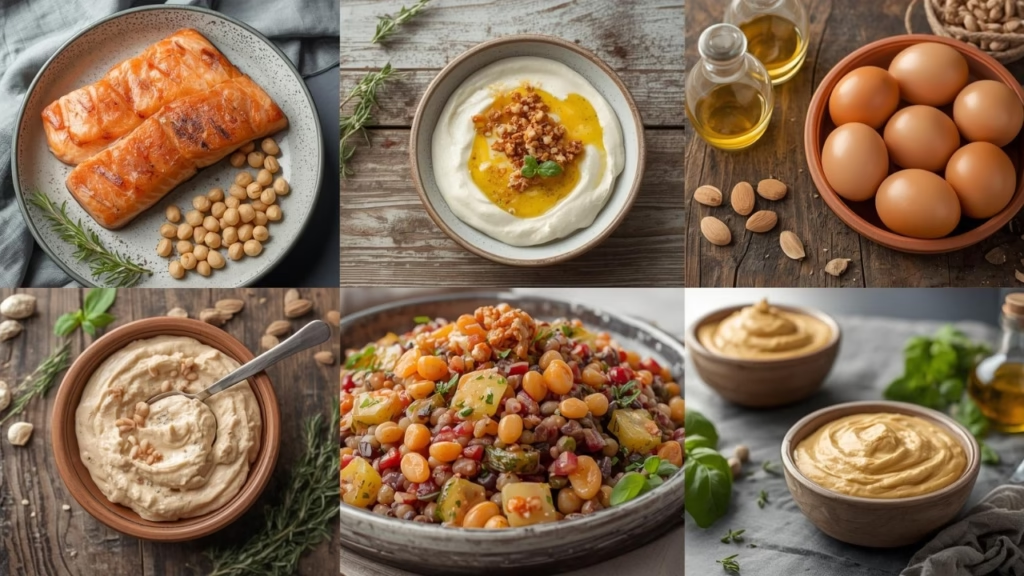
Overcoming Common Fusion Challenges
Asian spices with the Mediterranean diet occasionally present challenges that become easier to navigate with experience. One common issue is overpowering dishes with too many competing flavors. Start conservatively—add one or two Asian spices to a familiar Mediterranean dish before attempting more complex combinations. Your palate needs time to understand how these flavors interact, and gradual progression prevents overwhelming results.
Balancing bold Asian spices with Mediterranean subtlety requires a light touch initially. While Asian cuisines often embrace intense flavors, Mediterranean cooking tends toward more restrained seasoning that allows ingredient quality to shine. When introducing star anise or five-spice powder to Mediterranean dishes, use half the amount you might in traditional Asian cooking. You can always add more, but you can’t remove excess spice from a finished dish.
Some people worry about authenticity when fusing cuisines. Release this concern—culinary evolution has always involved cultural exchange and adaptation. Italian tomatoes came from the Americas, Mediterranean olive oil found its way to California, and Asian spices traveled ancient trade routes that linked East and West for millennia. You’re participating in food’s natural evolution, not violating sacred culinary rules. Focus on creating delicious, nourishing meals that work for your palate and health goals.
Ingredient availability can sometimes limit fusion cooking, particularly for fresh aromatics like lemongrass or galangal. When faced with this challenge, focus on the Asian spices most readily available—ginger, turmeric, cinnamon, star anise, and Chinese five-spice powder cover significant ground and appear in most well-stocked grocery stores. Dried forms of herbs and spices, while less vibrant than fresh, still contribute meaningful flavor and health benefits. Build your fusion practice around accessible ingredients, exploring more exotic options as your local market expands or you develop Asian grocery store relationships.
Making This Fusion Sustainable and Enjoyable
Asian spices with the Mediterranean diet succeed long-term when you approach fusion as an adventure rather than a rigid formula. Allow yourself to experiment, accepting that some combinations will work brilliantly while others teach you what doesn’t work. Keep notes on your favorite discoveries—which spice combinations elevated which dishes, what ratios felt balanced, and how your family responded to different fusion attempts.
Seasonal eating, central to Mediterranean philosophy, works beautifully with fusion spicing. Summer’s abundant tomatoes, zucchini, and eggplant pair wonderfully with lighter Asian aromatics like lemongrass and fresh ginger. Winter’s heartier vegetables and longer cooking times welcome warming spices like star anise, cinnamon, and dried ginger. Allowing the seasons to guide both your ingredients and spice choices keeps your meals aligned with natural rhythms while preventing boredom.
Social eating, another Mediterranean diet pillar, extends naturally to fusion cooking. Sharing fusion dishes with friends and family creates opportunities for conversation about food, health, and culture. These meals become teaching moments where you can discuss the health benefits of various spices or the fascinating historical connections between Mediterranean and Asian cuisines. Food shared with others, prepared with intention and care, nourishes far beyond its nutritional content.
Remember that perfection isn’t the goal—consistent progress toward healthier, more flavorful eating is what matters. Some days you’ll create fusion masterpieces that rival restaurant dishes. Other days you’ll simply add grated ginger to your basic tomato sauce or sprinkle turmeric on roasted vegetables. Both approaches count as success. The Mediterranean diet’s longevity benefits stem from sustainable adherence to its principles, and that sustainability comes from keeping meals enjoyable, practical, and varied enough to prevent monotony.
The Future of Your Fusion Kitchen
Asian spices with the Mediterranean diet represent more than a trendy cooking approach—they offer a sustainable path toward more flavorful, health-promoting eating that draws from humanity’s collective culinary wisdom. As you develop comfort with fusion cooking, you’ll discover that the boundaries between cuisines matter less than the principles they share: celebrating fresh ingredients, using spices for both flavor and health, building meals around plants, and finding joy in the act of eating well.
Your fusion journey will evolve uniquely based on your preferences, heritage, and health goals. Perhaps you’ll gravitate toward Mediterranean-Japanese fusion, emphasizing miso, ginger, and sesame with olive oil and vegetables. Maybe Chinese-Mediterranean combinations will captivate you, with five-spice powder enhancing lamb dishes and star anise perfuming fish stews. Indian-Mediterranean fusion might become your specialty, with turmeric, coriander, and cumin elevating chickpea dishes and vegetable preparations.
The skills you develop through fusion cooking—understanding flavor balance, working confidently with diverse spices, and adapting recipes to suit your needs—transfer to all aspects of your culinary life. You become a more intuitive, creative cook capable of transforming simple ingredients into meals that nourish body and soul. This culinary confidence often inspires broader healthy lifestyle changes, as cooking well at home naturally encourages better eating habits overall.
Start today with whatever Asian spice sits in your cabinet and whatever Mediterranean ingredient fills your refrigerator. Grate fresh ginger into your next olive oil and lemon dressing. Add turmeric to your chickpea stew. Experiment with star anise in your next tomato-based fish dish. Each small fusion step builds toward a more flavorful, healthful way of eating that honors both ancient wisdom and modern nutritional science. Your body and taste buds will thank you for this delicious journey where East meets West on your plate.
SOURCES
We carefully draw from trusted, evidence-backed sources to ensure our content’s accuracy and reliability.
Harvard T.H. Chan School of Public Health – The Mediterranean diet supports heart health, longevity, and reduced inflammation.
National Center for Complementary and Integrative Health (NCCIH) – Turmeric’s curcumin compound provides powerful anti-inflammatory and antioxidant benefits.
Cleveland Clinic – Combining spices like ginger and cinnamon can help regulate blood sugar and improve digestion.
Mayo Clinic – Healthy fats like olive oil improve nutrient absorption and support cardiovascular wellness.
NIH (National Institutes of Health) – Dietary polyphenols and antioxidants from herbs and spices reduce oxidative stress and chronic disease risk.
American Heart Association – The Mediterranean diet’s focus on fish, olive oil, and vegetables helps lower cholesterol and improve heart function.

Hello! I’m Sangay Choda, the creator of Mediterranean Diet Choice.
I’m not a doctor or licensed dietitian — I’m a health enthusiast who has spent years exploring the Mediterranean lifestyle and its proven benefits for long-term wellness, balance, and longevity.
My interest in this way of living began with a simple goal: to understand how everyday food choices can protect our hearts, improve energy, and support a happier life. Over time, I have researched and curated information from trusted medical and nutritional authorities, such as:
Harvard T.H. Chan School of Public Health
Mayo Clinic
World Health Organization (WHO)
National Institutes of Health (NIH) and more
I take complex, research-backed insights from these sources and transform them into easy-to-read, practical guides that anyone can apply — especially those looking to live healthier without restrictive diets or complicated plans.
While I do not offer medical advice, every article on this website is created with care, transparency, and a commitment to evidence-based information. My mission is to help readers make informed choices for a balanced, Mediterranean-inspired lifestyle.
Disclaimer: The content on this site is for informational and educational purposes only and should not be used as a substitute for professional medical advice. Always consult a qualified healthcare provider before making significant health or dietary changes. For more details, please visit our Disclaimer page.
For additional information about this website and its purpose, visit our About page. You can also review our Terms & Conditions to understand your rights and responsibilities when using this site.
Thank you for visiting Mediterranean Diet Choice.If you have questions, suggestions, or wish to collaborate, feel free to reach out at contact@mdietchoice.com or contact us.

